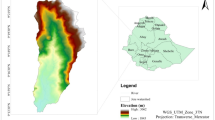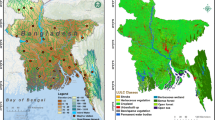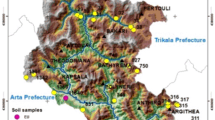Abstract
Among the land degradation processes, gully erosion is the one that poses more environmental and societal challenges in arid regions. Predicting spatiotemporal gully development in a region under changing conditions is important to adopt proper mitigation measures. Here we investigate the Ghapan-Olya watershed in Golestan province in Iran, which is affected by many erosional landforms, including gully phenomena. We apply the pixel-based distributed LANDPLANER model to predict where rainfall induced gullies will occur by exploiting input maps including UAV data, the region soil, and seasonal land use information. We compare our topographic thresholds and an erosion index with field observations through the application of quantitative metrics such as sensitivity, specificity, fallout, precision, and recall. Our study reveals that the spatial density of the gully’s location is more frequently predicted in the areas with an altitude of about 200–300 m, steep slope (between 15 and 30 degrees), and low average accumulation value (< 100) in the southeast facing slope. We obtain higher values of erosion index and topographic threshold for the minimum curve number where intense rainfalls are more frequent and where land use and cover conditions are more predisposing for gully occurrence. We obtain the largest values of soil erosion indices in the fall scenario when the daily rainfall is 80 mm (6.27), followed by the summer scenario with 80 mm daily rainfall (4.88), and spring again with 80 mm daily rainfall (2.99). In addition, topographic threshold maps illustrate the largest amount of soil erosion for the curve number scenario (without considering daily rainfall) in autumn. Our approach allows simulating gully erosion under changing conditions.










Similar content being viewed by others
References
Agostini M, Mondini AC, Torri D, Rossi M (2022) Modelling seasonal variation of gully erosion at the catchment scale. Earth Surf Proc Land 47(2):436–458
Bernatek-Jakiel A, Kacprzak A, Stolarczyk M (2016) Impact of soil characteristics on piping activity in a mountainous area under a temperate climate (Bieszczady Mts., Eastern Carpathians). Catena 141:117–129
Cama M, Schillaci C, Kropáček J, Hochschild V, Bosino A, Märker M (2020) A probabilistic assessment of soil erosion susceptibility in a head catchment of the Jemma Basin, Ethiopian Highlands. Geosciences 10(7):248
Chakrabortty R, Pal SC, Santosh M, Roy P, Chowdhuri I (2022) Gully erosion and climate induced chemical weathering for vulnerability assessment in sub-tropical environment. Geomorphology 398:108027
Chowdhuri I, Pal SC, Arabameri A, Saha A, Chakrabortty R, Blaschke T, Pradhan B, Band SS (2020) Implementation of artificial intelligence based ensemble models for gully erosion susceptibility assessment. Remote Sens 12(21):3620
Conoscenti C, Agnesi V, Angileri S, Cappadonia C, Rotigliano E, Märker M (2013) A GIS-based approach for gully erosion susceptibility modelling: a test in Sicily, Italy. Environ Earth Sci 70:1179–1195
De Roo APJ, Wesseling CG, Ritsema CJ (1996) LISEM: a single-event physically based hydrological and soil erosion model for drainage basins. I: theory, input and output. Hydrol Process 10(8):1107–1117
Dube HB, Mutema M, Muchaonyerwa P, Poesen J, Chaplot V (2020) A global analysis of the morphology of linear erosion features. Catena 190:104542
Faulkner H (2006) Piping hazard on collapsible and dispersive soils in Europe. Soil Erosion Europe 537–562
Frankl A, Poesen J, Deckers J, Haile M, Nyssen J (2012) Gully head retreat rates in the semi-arid highlands of northern Ethiopia. Geomorphology 173–174:185–195
Grellier S, Kemp J, Janeau JL, Florsch N, Ward D, Barot S, Podwojewski P, Lorentz S, Valentin C (2012) The indirect impact of encroaching trees on gully extension: a 64 year study in a sub-humid grassland of South Africa. Catena 98:110–119
Hong YANG, Adler RF (2007) Toward an early-warning system for global landslides triggered by rainfall and earthquake. Int J Remote Sens 28(16):3713–3719
Hosseinalizadeh M, Alinejad M, Mohammadian Behbahani A, Khormali F, Kariminejad N, Pourghasemi HR (2020) A review on the gully erosion and land degradation in Iran. Gully Erosion Stud India Surround Regions 393–403
Kakembo V, Rowntree KM (2003) The relationship between land use and soil erosion in the communal lands near Peddie Town, Eastern Cape, South Africa. Land Degrad Dev 14(1):39–49
Kariminejad N, Rossi M, Hosseinalizadeh M, Pourghasemi HR, Santosh M (2020) Gully head modeling in iranian loess plateau under different scenarios. Catena 194:104769
Karydas C, Panagos P (2020) Toward an assessment of the ephemeral gully erosion potential in greece using google earth. Water 12(2):603
Liao Z, Hong Y, Wang J, Fukuoka H, Sassa K, Karnawati D, Fathani F (2010) Prototyping an experimental early warning system for rainfall-induced landslides in Indonesia using satellite remote sensing and geospatial datasets. Landslides 7(3):317–324
Liao Z, Hong Y, Kirschbaum D, Liu C (2012) Assessment of shallow landslides from Hurricane Mitch in Central America using a physically based model. Environ Earth Sci 66(6):1697–1705
Lucà F, Conforti M, Robustelli G (2011) Comparison of GIS-based gullying susceptibility mapping using bivariate and multivariate statistics: Northern Calabria, South Italy. Geomorphology 134:297–308
Mergili M, Marchesini I, Rossi M, Guzzetti F, Fellin W (2014) Spatially distributed three- dimensional slope stability modeling in a raster GIS. Geomorphology 206:178–195
Neverman AJ, Donovan M, Smith HG, Ausseil AG, Zammit C (2023) Climate change impacts on erosion and suspended sediment loads in New Zealand. Geomorphology 108607
Okoli J, Nahazanan H, Nahas F, Kalantar B, Shafri HZM, Khuzaimah Z (2023) High-resolution lidar-derived DEM for landslide susceptibility assessment using AHP and fuzzy logic in serdang. Malaysia Geosci 13(2):34
Olivier G, Van De Wiel MJ, De Clercq WP (2023) Intersecting views of gully erosion in South Africa. Earth Surf Proc Land 48(1):119–142
Pal SC, Arabameri A, Blaschke T, Chowdhuri I, Saha A, Chakrabortty R, Lee S, Band SS (2020) Ensemble of machine-learning methods for predicting gully erosion susceptibility. Remote Sens 12(22):3675
Pal SC, Chakrabortty R, Arabameri A, Santosh M, Saha A, Chowdhuri I, Roy P, Shit M (2022) Chemical weathering and gully erosion causing land degradation in a complex river basin of Eastern India: an integrated field, analytical and artificial intelligence approach. Nat Hazards 110(2):847–879
Peruccacci S, Brunetti MT, Gariano SL, Melillo M, Rossi M, Guzzetti F (2017) Rainfall thresholds for possible landslide occurrence in Italy. Geomorphology 290:39–57
Rossi M, Torri D, Santi E (2015) Bias in topographic thresholds for gully heads. Nat Hazards 79(1):51–69
Rossi M, Torri D, De Geeter S, Cremer C, Poesen J (2022) Topographic thresholds for gully head formation in badlands. Earth Surf Proc Land. https://doi.org/10.1002/esp.5473
Roy P, Pal C, Arabameri S, Chakrabortty A, Pradhan R, Chowdhuri B, Lee I, Bui T (2020) Novel ensemble of multivariate adaptive regression spline with spatial logistic regression and boosted regression tree for gully erosion susceptibility. Remote Sens 12(20):3284
Roy P, Pal SC, Janizadeh S, Chakrabortty R, Islam ARMT, Chowdhuri I, Saha A (2022) Evaluation of climate change impacts on future gully erosion using deep learning and soft computational approaches. Geocarto Int 1–31
Rozos D, Skilodimou HD, Loupasakis C, Bathrellos GD (2013) Application of the revised universal soil loss equation model on landslide prevention. An example from N. Euboea (Evia) Island, Greece. Environ Earth Sci 70:3255–3266
Saha A, Pal SC, Chowdhuri I, Islam ARMT, Roy P, Chakrabortty R (2022) Land degradation risk dynamics assessment in red and lateritic zones of eastern plateau, India: a combine approach of K-fold CV, data mining and field validation. Ecol Inf 69:101653
Sidle RC, Jarihani B, Kaka SI, Koci J, Al-Shaibani A (2019) Hydrogeomorphic processes affecting dryland gully erosion: implications for modeling. Prog Phys Geograph Earth Environ 43(1):46–64
Spalevic V, Barovic G, Vujacic D, Curovic M, Behzadfar M, Djurovic N, Dudic B, Billi P (2020) The impact of land use changes on soil erosion in the river basin of Miocki Potok. Montenegro Water 12(11):2973
Torri D, Poesen J (2014) A review of topographic threshold conditions for gully head development in different environments. Earth Sci Rev 130:73–85
Torri D, Poesen J, Rossi M, Amici V, Spennacchi D, Cremer C (2018) Gully head modelling: a Mediterranean badlands case study.Earth Surf. Process. Landforms1–45
USDA NCRS (2012) National Engineering handbook. United States Department of agriculture (USDA) Natural Resources conservation service (NRCS)
Vacha D, Mandrone G, Morresi D (2022) Mapping Post-fire monthly erosion rates at the catchment scale using empirical models implemented in GIS A case study in northern Italy. Landslide Res Technol 1(1):99–112
Valentin C, Poesen J, Li Y (2005) Gully erosion: impacts, factors and control. Catena 63:132–153
Valkanou K, Karymbalis E, Bathrellos G, Skilodimou H, Tsanakas K, Papanastassiou D, Gaki-Papanastassiou K (2022) Soil loss potential assessment for natural and post-fire conditions in Evia Island. Greece Geosci 12(10):367
Vanmaercke M, Panagos P, Vanwalleghem T, Hayas A, Foerster S, Borrelli P, Rossi M, Torri D, Casali J, Borselli L, Vigiak O (2021) Measuring, modelling and managing gully erosion at large scales: a state of the art. Earth Sci Rev 218:103637
Wilson G (2011) Understanding soil-pipe flow and its role in ephemeral gully erosion. Hydrol Process 25(15):2354–2364
Zeng Y, Meng X, Wang B, Li M, Chen D, Ran L, Fang N, Ni L, Shi Z (2023) Effects of soil and water conservation measures on sediment delivery processes in a hilly and gully watershed. J Hydrol 616:128804
Funding
This study was supported by Iran National Science Foundation (INSF) (Grant No. 99011991).
Author information
Authors and Affiliations
Corresponding author
Ethics declarations
Conflict of interest
The authors declare that they have no conflict of interest.
Additional information
Publisher’s Note
Springer Nature remains neutral with regard to jurisdictional claims in published maps and institutional affiliations.
Rights and permissions
Springer Nature or its licensor (e.g. a society or other partner) holds exclusive rights to this article under a publishing agreement with the author(s) or other rightsholder(s); author self-archiving of the accepted manuscript version of this article is solely governed by the terms of such publishing agreement and applicable law.
About this article
Cite this article
Kariminejad, N., Pourghasemi, H.R., Hosseinalizadeh, M. et al. Evaluating land degradation by gully erosion through soil erosion indices and rainfall thresholds. Nat Hazards 117, 3353–3369 (2023). https://doi.org/10.1007/s11069-023-05990-3
Received:
Accepted:
Published:
Issue Date:
DOI: https://doi.org/10.1007/s11069-023-05990-3




